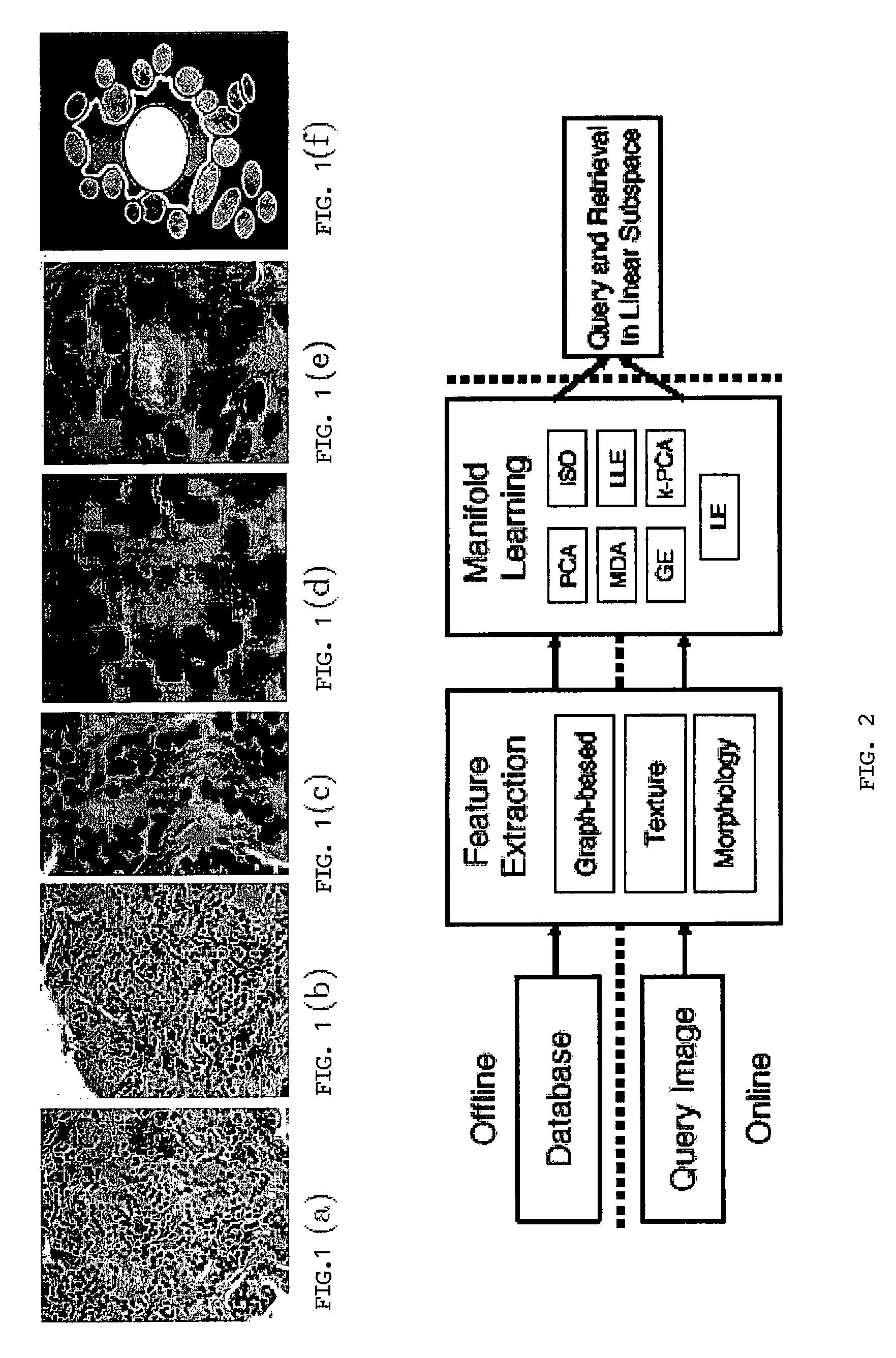Malignancy diagnosis using content-based image retreival of tissue histopathology
a content-based image and histopathology technology, applied in image analysis, image enhancement, instruments, etc., can solve the problems of inability to quantitatively evaluate the system with different feature sets, inability to perform ml methods, and often deadly diagnosis and treatment in the late stages, so as to reduce the dimensionality of extracted feature data and increase magnification
- Summary
- Abstract
- Description
- Claims
- Application Information
AI Technical Summary
Benefits of technology
Problems solved by technology
Method used
Image
Examples
example 1
Using Manifold Learning for Content-Based Image Retrieval of Prostate Histopathology
[0067]Prostate cancer is the most commonly diagnosed cancer among males in the U.S., with 200,000 new cases and 27,000 deaths predicted for 2007 (source: American Cancer Society). Currently manual examination of prostate biopsy samples under a microscope by an expert pathologist is the gold standard of prostate cancer diagnosis and grading. In the U.S., the most common system of numbering or \grading” prostate tissue (assessing degree of malignancy) is the Gleason scale [1], which assigns grades on a scale from 1 (well-differentiated, relatively benign tissue) to 5 (non-differentiated tissue, highly invasive cancer).
[0068]The Gleason paradigm illustrates how cancer grades differ in terms of their architecture (spatial arrangement of nuclei and glands within the tissue with respect to their centers of mass) and morphology (shape and size of glands and nuclei). Glands and nuclei both express architectu...
example 2
Grading of Prostate Cancer Using CBIR
[0093]The current protocol for prostate cancer diagnosis involves manual analysis of prostate biopsy tissue by a pathologist to determine the presence or absence of cancer in a tissue sample, followed by Gleason grading to assign a number between 1 (early stage cancer) and 5 (highly infiltrative cancer) to grade the invasiveness of the cancer. Gleason grading is currently done by visual analysis of the arrangement, size, and shape of the gland structures and nuclei within the tissue sample. Recently however a number of problems have been identified with the Gleason system:
[0094]Variability: Significant levels of inter and intra-observer variability in manual grading of prostate cancer was observed with the rates of undergrading tissue patterns (assigning a tissue a grade lower than its actual grade) as high as 47%. FIG. 6 illustrates these clinical problems, as the difference between intermediate cancer grades (grade 3 (FIG. 1 (a)) and grade 4 (F...
example 3
Grading of Breast Cancer Using CBIR
Computerized Feature Extraction to Develop Quantitative Signatures for Breast Cancer Grades
[0124]Breast tissue samples are scanned into the computer at 40× optical magnification using a whole-slide digital scanner, where they are deconstructed into constituent scales. The grading of breast tissue is done across multiple magnifications. At lower magnifications only textural attributes and, overall features of tissue architecture including tubule formation are apparent, while at higher magnifications nuclear and other cellular cytological details become visible. Texture features include 13 Haralick texture features, along with several first-order statistical texture features. Also extracted is a series of steerable Gabor filter features, which provide a varying filter response to textural differences at a series of scales and orientations. FIGS. 10(b)-(e), and 10(g)-(j) represent the corresponding texture feature representations (Gabor, Sobel, Gradie...
PUM
 Login to View More
Login to View More Abstract
Description
Claims
Application Information
 Login to View More
Login to View More - R&D
- Intellectual Property
- Life Sciences
- Materials
- Tech Scout
- Unparalleled Data Quality
- Higher Quality Content
- 60% Fewer Hallucinations
Browse by: Latest US Patents, China's latest patents, Technical Efficacy Thesaurus, Application Domain, Technology Topic, Popular Technical Reports.
© 2025 PatSnap. All rights reserved.Legal|Privacy policy|Modern Slavery Act Transparency Statement|Sitemap|About US| Contact US: help@patsnap.com



